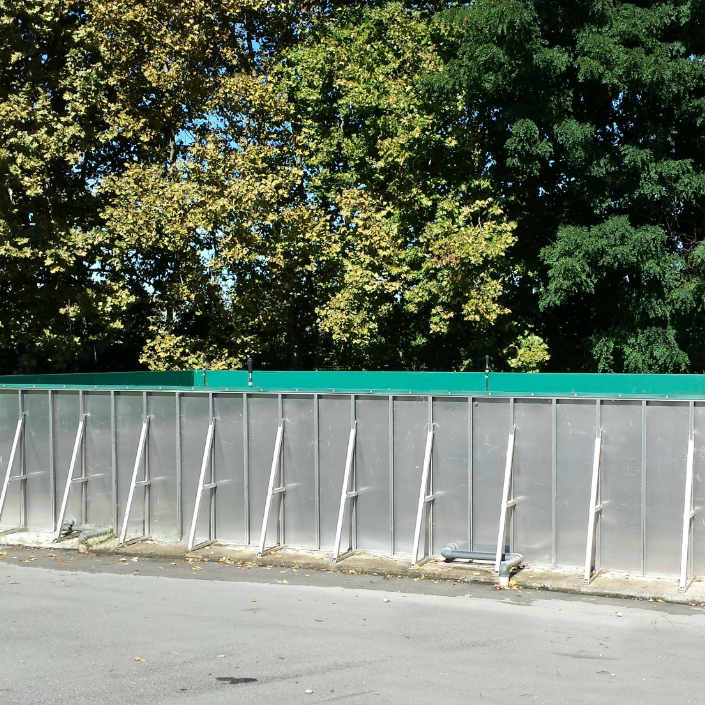BIOFILTERS
Biofiltration uses microorganisms fixed to a porous medium to break down pollutants present in an air stream.
Biofiltration uses microorganisms fixed to a porous medium to break down pollutants present in an air stream. Biological filtration processes are used in some industrial sectors, such as chemical, steel or food industry and livestock farms, but also in wastewater (civil and industrial) and solid waste treatment plants. As opposed to chemical-physical systems, biofilters consent to obtain better removal yields with minimal O&M costs. Biofilter process can be compared with a wastewater treatment; as in this case, pollutants removal is realized by means of microorganisms (bacteria, fungi, actinomycetes). Pollutants that can be degraded (through biological reactions o oxidation, reduction and hydrolysis) are inorganic compounds (H2S and NH3), aromatic and aliphatic organic compounds (acid, hydrocarbon and so on).
The microorganisms grow in a biofilm on the surface of a medium or are suspended in the water phase surrounding the medium particles. The filter-bed medium consists of relatively inert substances (compost, peat, wood, …) which ensure large surface attachment areas and additional nutrient supply.
As the air passes through the bed, the contaminants in the air phase sorb into the biofilm and onto the filter medium, where they are biodegraded. Biofilters are not filtration units as strictly defined. Instead, they are systems that use a combination of basic processes: absorption, adsorption, degradation, and desorption of gas-phase contaminants. The height of the filter material is between 1.0 m and 2.0 m, with a maximum of two to three layers.
In order to obtain the maximum removal yield as possible, filtering materials must have the following characteristics: high porosity, high water holding capacity (critical issue for microbial life) and high nutrients content. The filling material have to maintain these features during his life as long as possible. Moreover, properties of filling material also affect O&M costs (e.g., high porosity reduces fan’s power consumption).
The majority of biofilters in operation are open-bed filters, which are less costly than enclosed.
The specific load of the filter bed is between 80 and 100 Nm3/h per m3 of filter bed. The residence time to allow an effective abatement, e.g., of odour, depends on the pollutant concentration. As a rough guide, a minimum residence time of 30 s to 45 s should be aimed for.
The lifespan of the organic filtering material (e.g. root wood, tree bark, peat, compost, coco material and/or mixtures of these – see or section is primarily determined by acidification (N, S and Cl), depletion and/or poisoning and pressure drop. Sometimes, additional nutrients need to be added if the organic filtering material degrades too slowly [Schenk et al., 2009].
With biofilters the filter material has to be regularly worked up and disposed of from time to time. Waste gas channelisation can occur through the filter bed, thereby decreasing the biofilter efficiency. The filtering material should be replaced periodically (every 0.5–5 years), depending on the type of packing material and the composition of the gases.
Finally, the moistening filtering bed device needs protection against freezing in regions where temperatures are substantially below 0 °C as well as cooling is necessary for applications with hot airflows (> 38 °C). This can be realized by a mixture of outside air, a (single-pass) water scrubber or a heat exchanger/condenser.
For more info, check our section
Arte e Lavoro can design and realize biofilters using the following materials:
- Aluminium-magnesium alloy, great for placing bio filters on sheds roof and harmful environments
- AISI (304 or 316)
- Galvanized steel
- Masonry (i.e., walls realized with reinforced concrete or bricks)
- Sandwich panel.
Our team of A&L Engineering will be able to select the most suitable air diffusion system for your biofilter. For more info on the air diffusion systems we propose, check the section.
If required, it’s possible to plan portable or modular bio filters having same size of dumpsters.
ADVANTAGES
Biofilters are known for: low operating and capital costs, effective removal of compounds, low pressure drop.
Fonte: “Best Available Tecniques, Reference Document for the Waste Treatments Industries”. I dati riportati non costituiscono informazione tecnica vincolante e sono menzionati a titolo di esempio.
BOUNDARY CONDITIONS / DESIGN PARAMETERS
In the following table, typical biofilter operating conditions for waste air treatment are reported (Source: Deshusses, M.A., Biodegradation of Mixtures of Ketone Vapours in Biofilters for the Treatment of Waste Air, Ph.D. thesis, Swiss Federal Institute of Technology, Zurich, 1994).
| Parameter | Typical value |
|---|---|
| Biofilter layer height | 1.0 ÷ 2.0 m |
| Biofilter area | 1.0 ÷ 3.000 m2 |
| Waste air flow | 50 ÷ 300,000 m3/h1 |
| Biofilter surface loading | 5 ÷ 500 m3 h-1/m2 |
| Biofilter volumetric loading | 5 ÷ 500 m3 h-1/m3 |
| Bed void volume | 50 % |
| Mean effective gas residence time | 15 ÷ 60 s |
| Pressure drop per meter of bed height | 0.2 ÷ 1.0 cm water gauge (max 10 cm) |
| Inlet pollutant and/or odor concentration | 0.01 ÷ 5 g/m3, 500 ÷ 50,000 OU/m3 |
| Operating temperature | 15 ÷ 30°C |
| Inlet air relative humidity | > 98 % |
| Water content of the support material | 60 % by mass |
| pH of the support material | 6 ÷ 8 |
| Typical removal efficiencies | 60 ÷ 100 % |
Please, consider that data shown in table do not constitute technical information and are mentioned by way of example.
APPLICATIONS AND PERFORMANCES
Biofilters are effective and economic for high flow air with a “low” pollutant concentration. Compounds that have been effectively treated within the biofilters are soluble and biodegradable molecules, such as:
- organic molecules, even complex
- high olfactory impact molecules as aromatic and aliphatic hydrocarbons, fat acid, mercaptans, ammines, amides, aldehydes, ketones
- organic solvents
- inorganic molecules as hydrogen sulphide and ammonia
The treatment of chlorinated compounds has to be carefully evaluated.
The biofilter can reduce up to 99% of osmogenes compounds in the air stream. The following table shows the compounds on which the biofilter is effective and the obtainable removal yield.
| COMPOUND | VALUE % (MIN-MAX) |
|---|---|
| Organic compounds/ volatile organic compounds (VOCs) | 99 |
| Ammonia | 92 |
| Mercaptans | 75-95 |
| Nitrogen compounds | 98 |
| Aldehydes | 93-99 |
| Sulphide hydrogen | 75-99 |
| Other components | 91-99 |
For some odorous compounds (e.g., mercaptans, H2S), abatement efficiencies of 75% are a minimum. In general, using a scrubber and biofilter in combination can increase performance.
Please, consider that data shown in this section do not constitute technical information and are mentioned by way of example.
ENERGY CONSUMPTION
Energy consumption depends on fan’s power, which are chosen according to the site conditions (e.g., ducts length and diameter). In addition, if cooling/heating system are used, they can have a remarkable impact on the cost. The selection of an appropriate filtering media in combination with a periodic check of the system are crucial issues to reduce energy requirements.
ENVIRONMENTAL FEATURES
Leachate produced by biofilter can be treated within the plant (i.e., where biofilter is operating) or disposed of. Exhaust filtering material, based on its chemical/physical characteristics, can be composted or disposed of.
RELATED PRODUCTS
- microorganisms (bacteria, actinomycetes, fungi)
- filling materials
- equipment and probes for process monitoring
- weather station and software for modelling odour diffusion into the atmosphere
- remote controller (e.g., SCADA or PLC)
Some references can be found here.


 @airqualitymaker.com
@airqualitymaker.com @airqualitymaker.com
@airqualitymaker.com